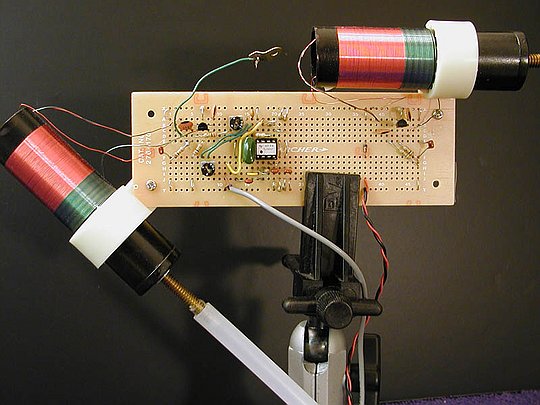"A coiled/helical antenna or antenna part could be seen as mainly a coil/inductance, but between the windings if there is a small air gap there is also capacitance, and so it probably has some pattern of its own resonances, ..." - DreadVox
Scientifically, capacitance between windings isn't a real thing due to the very slight phase difference between adjacent windings. However there can be real C between the ends of the coil (if the coil is at or near resonance).
"... and to the connected circuit it 'looks' a lot longer/taller than it physically is."
True. The screen door spring I tried a long time ago is 1/2" in diameter and 425mm long. There are 6 turns / 10mm or 0.6 t/mm, * 425mm = 255 turns. L = pi * D, so there is ~40mm length per turn, * 255 turns = 10.2m length. A "standard" Theremin antenna is maybe 0.35m, so the spring is approx. 30 times longer. Plugging the coil dimensions into Inca, I get 24uH. Measuring it with my LC meter I get 31.27uH.
"In the common forms of pitch rods on theremins, the antenna is very short relative to the wavelength of the variable oscillator, so it doesn't couple to it in the sense of a transmitting or receiving antenna and in practice acts as one of the plates/electrodes of a capacitor, of which the surroundings, including the body/arm/hand/fingers of the player form the other half of that (variable) capacitor."
A high Q antenna uses a physically short element (sometimes with a "capacitance hat" on top) coupled to a coil. To put "short" in perspective, the wavelength of 1MHz is 300m long. So the screen door spring is 10/300 = 1/30 of a wavelength @ 1MHz, which is quite short. So it isn't a good RF emitter, and is acting largely in the capacitive domain (like any other Theremin antenna).
"The electrodeum helical antenna, to the theremin circuitry appears as a significantly longer/taller antenna than the conventional pitch rods, and I understood that you also use a somewhat higher frequency for the reference and variable oscilators. All in all the helical antenna gets closer to match the oscillator as an antenna in the transmitting/receiving sense. Perhaps in practice the result is a more lineairly spread pitch field, I can describe what I see as the differnces, but lack in depth technical knowledge to predict/understand to what kind of differences in behaviour and playability they lead. What role the resonances of the helical antenna plays and what would be the best way the variable oscilator and a helical antenna are combined/matched in terms of frequencies would be an area to explore further."
More perspective: if the spring antenna intrinsic C is ~10pF (measured via my LC meter, and a good ballpark figure in general) then the resonant frequency with 30uH would be about 10 MHz, or at least an order of magnitude above the frequency of the oscillator driving it, so I don't see a lot to explore here. AFAIK, no one else has reported that this particular antenna geometry is more linear than any other, so we only have the inventor's claims. And the inventor ironically hates engineering, so take that for what it's worth and good luck to y'all.




